Marvel’s The Monster of Frankenstein, Part Two
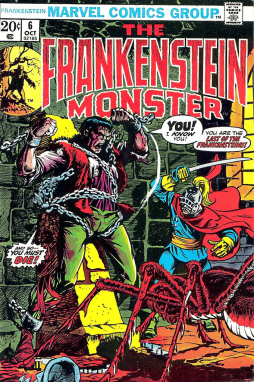 Read Part One of this article here. Click on images for larger versions.
Read Part One of this article here. Click on images for larger versions.
The 19th Century adventures of Mary Shelley’s famous monster following Gary Friedrich and Mike Ploog’s adaptation of the classic novel continued in Issue 5 of Marvel’s The Monster of Frankenstein with another standalone filler story. This time out it is a more serviceable horror yarn that sees the Monster bravely rescuing a beautiful girl from being burned at the stake. She claims that her town is under the spell of a demon dressed in black that only she could resist. The Monster confronts and subdues her abusive father in his quest to end her persecution.
Along the way, there are hints that the girl is not as virtuous as she initially appeared. The Monster learns at the climax that the girl is actually a werewolf. The demon in black is revealed to be the village priest. The story is a familiar yarn having been utilized in numerous other comics and short stories for several prior decades. Gary Friedrich’s script puts the tested story to good use, but this is one of Mike Ploog’s less-inspired issues as artist.
Ploog’s swan song with the series was Issue 6. The title was modified slightly to The Frankenstein Monster starting with this issue. Ploog’s artwork here is simply stunning recalling at times Barry Windsor-Smith’s run on Marvel’s Conan the Barbarian. His Frankenstein Monster also strongly resembles Herb Trimpe’s interpretation of The Incredible Hulk and yet, there is much that is undeniably Ploog’s own brilliant style throughout. This final issue for the artist is his best for the series and does much to underline what made his artwork so beloved by comics fans.
The issue offers the first major plot advancement of the series as the Monster arrives in Ingolstadt and reaches Castle Frankenstein. Unfortunately, Friedrich seems to envision Europe at the end of the 19th Century as still being mired in the Dark Ages. Castle Frankenstein has been taken over by a tyrannical despot known as the Colonel. His Neanderthal servants (they appear to be the same ones seen in the Arctic in Issue 4) are capturing innocent victims from Ingolstadt to feed to the giant spider that lies in the pit beneath the Castle. The Monster joins a heroic Lieutenant in dispatching the Colonel and killing the giant spider. Castle Frankenstein is destroyed in the process as the Monster’s search for Frankenstein’s descendant continues.
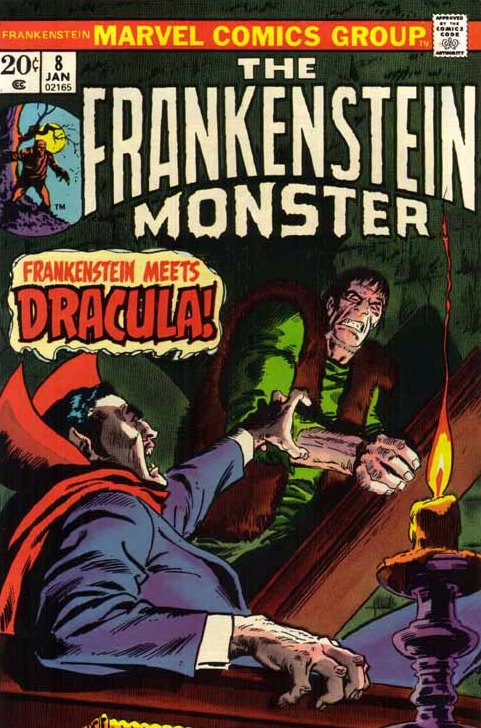 Issue 7 begins a three-part story arc pitting the Monster against Count Dracula, a character whose own contemporaneous Marvel series was outselling their Frankenstein title considerably. John Buscema is a talented artist, but his work here is strictly professional and sadly uninspired. This is routine comic art and certainly not what Gene Colan would have offered had this been an actual crossover with The Tomb of Dracula.
Issue 7 begins a three-part story arc pitting the Monster against Count Dracula, a character whose own contemporaneous Marvel series was outselling their Frankenstein title considerably. John Buscema is a talented artist, but his work here is strictly professional and sadly uninspired. This is routine comic art and certainly not what Gene Colan would have offered had this been an actual crossover with The Tomb of Dracula.
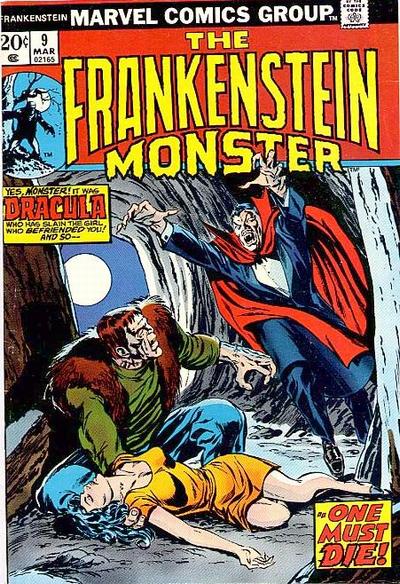 The extended storyline allows Friedrich to hit his pace as a scriptwriter for the first time with this title. This is great pulpy fun from the voyeuristic opening of Carmen the beautiful gypsy girl undressing to bathe in the river unaware that she is being observed by both the Monster and a giant homicidal hunchback named Drako whom she has spurned. The Monster saves the girl from being strangled by Drako and then befriends her grateful grandmother, the wizened gypsy fortune teller, Marguerita (a dead ringer for Maleva from Universal’s The Wolf Man).
The extended storyline allows Friedrich to hit his pace as a scriptwriter for the first time with this title. This is great pulpy fun from the voyeuristic opening of Carmen the beautiful gypsy girl undressing to bathe in the river unaware that she is being observed by both the Monster and a giant homicidal hunchback named Drako whom she has spurned. The Monster saves the girl from being strangled by Drako and then befriends her grateful grandmother, the wizened gypsy fortune teller, Marguerita (a dead ringer for Maleva from Universal’s The Wolf Man).
The Monster happily joins the gypsy encampment, but as always tragedy quickly follows any peaceful respite for our manmade Monster. Marguerita is actually a vampire who preys upon the villagers and succeeds in resurrecting Count Dracula by removing the stake from his heart as the first part reaches its conclusion.
Issue 8 moves along quickly with the first fight between the resurrected vampire lord and the Monster. Marguerita gets staked through the heart by the Monster, Dracula attacks Carmen, and the torch-bearing villagers string the Monster up to be burned at the stake as the penultimate chapter concludes in an unfortunate replay of the events of Issue 5.
Issue 9 brings the Dracula storyline to an exciting conclusion with the Monster escaping being burned at the stake only to drive wooden stakes through the hearts of both Carmen and Dracula as the issue ends with the unexpected appearance of Vincent Frankenstein, the descendant of the Monster’s creator who had hired Robert Walton IV to lead the expedition to recover the Monster from the Arctic in the first issue. Friedrich whets the reader’s appetite that he is finally building to the storyline the series has been leading up to and expectations for the next issue are suitably strong.
Issue 10 introduces us to Ivan, Vincent Frankenstein’s giant homicidal hunchbacked assistant (a dead-ringer for Drako in Issue 7 as Friedrich repeats himself yet again). Unsurprisingly, Vincent is revealed to be a classic mad scientist who is cruel and abusive to Ivan. The Monster is sedated and transported to Vincent’s London laboratory where he intends to transplant a fresh brain into the Monster to bring it under his control.
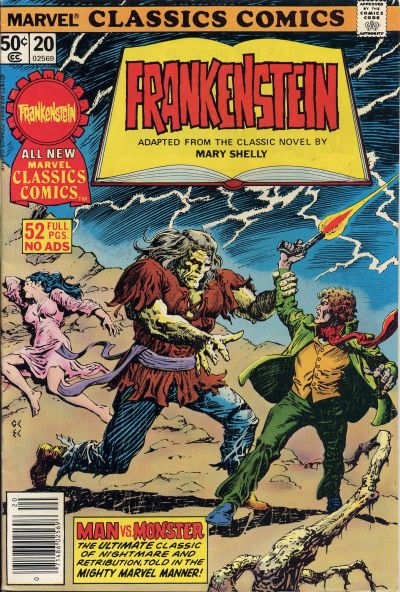 Issue 11 is the final “in-period” issue of the series as Marvel made the decision to update the setting to the early 1970s in an effort to inject life and revive the ailing series’ sales. Bob Brown replaced John Buscema as artist on this issue. It was a fill-in assignment for Brown. This final Victorian story is also Gary Friedrich’s swan song with the series.
Issue 11 is the final “in-period” issue of the series as Marvel made the decision to update the setting to the early 1970s in an effort to inject life and revive the ailing series’ sales. Bob Brown replaced John Buscema as artist on this issue. It was a fill-in assignment for Brown. This final Victorian story is also Gary Friedrich’s swan song with the series.
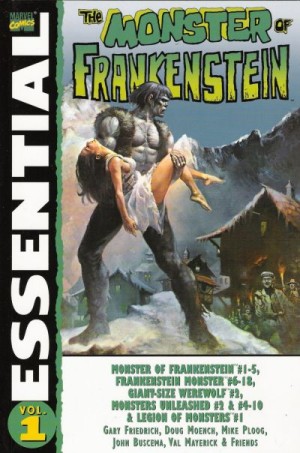 Vincent Frankenstein has spent a small fortune in his effort to perfect the Frankenstein Monster. Of course, his maltreatment of Ivan and his lack of care for his pregnant wife quickly proves his undoing. The story rushes to the unavoidably tragic ending with Vincent’s wife dying after giving birth to a son and Vincent is subsequently shot dead by his insane and resentful maid. The maid, Betty is left to raise the Frankenstein heir at the story’s conclusion and plant the seed for yet another retread of a Frankenstein descendant doomed to repeat history in a future issue. The Monster wanders off into the English countryside mistakenly believing the Frankenstein family has been wiped off the face of the Earth as this misbegotten series limps to the end of its first awkward incarnation.
Vincent Frankenstein has spent a small fortune in his effort to perfect the Frankenstein Monster. Of course, his maltreatment of Ivan and his lack of care for his pregnant wife quickly proves his undoing. The story rushes to the unavoidably tragic ending with Vincent’s wife dying after giving birth to a son and Vincent is subsequently shot dead by his insane and resentful maid. The maid, Betty is left to raise the Frankenstein heir at the story’s conclusion and plant the seed for yet another retread of a Frankenstein descendant doomed to repeat history in a future issue. The Monster wanders off into the English countryside mistakenly believing the Frankenstein family has been wiped off the face of the Earth as this misbegotten series limps to the end of its first awkward incarnation.
William Patrick Maynard was authorized to continue Sax Rohmer’s Fu Manchu thrillers beginning with The Terror of Fu Manchu (2009; Black Coat Press). He is currently working on a sequel, The Destiny of Fu Manchu as well as The Occult Case Book of Sherlock Holmes. To see additional articles by William, visit his blog at SetiSays.blogspot.com
[…] Part Two of this article here. […]